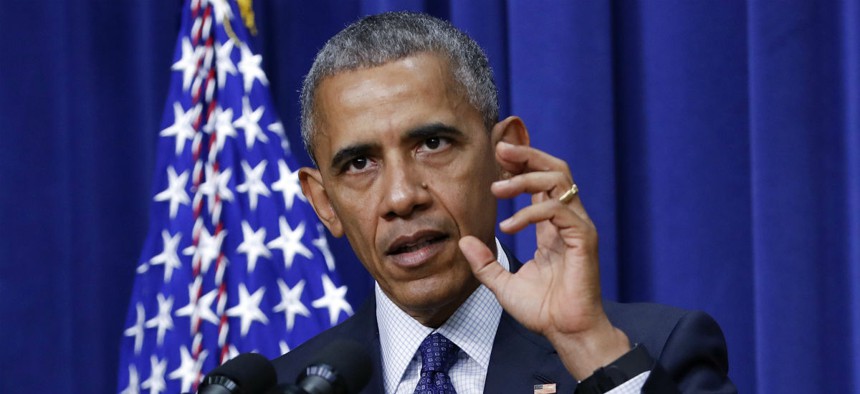
Pablo Martinez Monsivais/AP
Obama Issues Plan to Give Feds 1.6 Percent Pay Raise in 2017
Figure includes a 1 percent base boost, and a 0.6 percent locality pay bump.
This story has been updated.
President Obama issued an alternative pay plan Wednesday, giving civilian federal employees a 1.6 percent raise in 2017.
The total figure includes a 1 percent base increase, and a 0.6 percent locality pay bump, matching the amount the president requested in his fiscal 2017 budget proposal. Obama issued a separate plan providing a 1.6 percent boost in monthly basic pay rates for military service members.
Obama said he would make a decision by Nov. 30 regarding a locality pay plan. Locality pay rates vary by area.
The president just met his Aug. 31 deadline to formally announce his pay raise proposal for federal employees for the upcoming year. If the president fails to inform Congress of his alternative pay plan for feds by Aug. 31 each year, then the increase mandated by the 1990 Federal Employees Pay Comparability Act kicks in. Under FEPCA, the raise is determined by the change in the Employment Cost Index minus 0.5 percent. For 2017, that would have been around 2.1 percent.
Presidents, however, largely have ignored the FEPCA formula in their federal pay raise proposals, preferring to offer their own figure, which is allowed under the law. Congress created FEPCA, which provides an annual across-the-board salary boost and a locality pay adjustment for General Schedule employees, to close the public and private sector pay gap.
Feds received a 1.3 percent pay boost for 2016, which included locality pay adjustments. Obama has received criticism from federal employee advocates for giving historically low across-the-board raises to base pay in recent years -- following three years of no raises at all during the pay freeze -- and the locality pay areas and definitions announced at the end of last year provided the administration with a different avenue for increasing feds’ compensation.
Tony Reardon, president of the National Treasury Employees Union, said the 1.6 percent figure was “far too low” given the pay freeze and “meager” raises over the last few years. “We continue to highlight the impact on federal workers of low pay increases and the impact on federal agencies’ ability to recruit and retain the skilled workforce our nation needs,” Reardon said in a statement.
American Federation of Government Employees National President J. David Cox Sr. also was unimpressed with the 1.6 recommended raise. “President Obama acted because Congress has not. AFGE reiterates our call for Congress to pass a 5.3 percent pay raise in 2017 that will make up for years of neglect and begin to close the widening gap between employees in the federal and private sectors,” said Cox.
Obama said his pay raise recommendation for civilian federal workers “will not materially affect our ability to attract and retain a well-qualified federal workforce.”
Congress has the final say on any pay raise. Lawmakers could upend the president’s 1.6 percent recommendation and the FEPCA formula this fall by coming up with their own pay raise proposals for federal civilian employees, but it’s not likely at this point. Earlier this summer, the House passed the fiscal 2017 Financial Services and General Government Appropriations Act, allowing for a pay raise for federal workers next year. For the last several years, federal workers have ended up with the pay raise the president recommended.
Lawmakers in both chambers have introduced legislation that would give federal employees a 5.3 percent pay hike across-the-board in 2017, but those bills are not likely to gain any traction when Congress returns to a busy fall after summer recess. The fiscal year ends on Sept. 30, and Congress has yet to agree on any fiscal 2017 spending bills.
If Congress doesn't intervene, Obama's 1.6 percent recommendation will take effect on Jan. 1, 2017.







